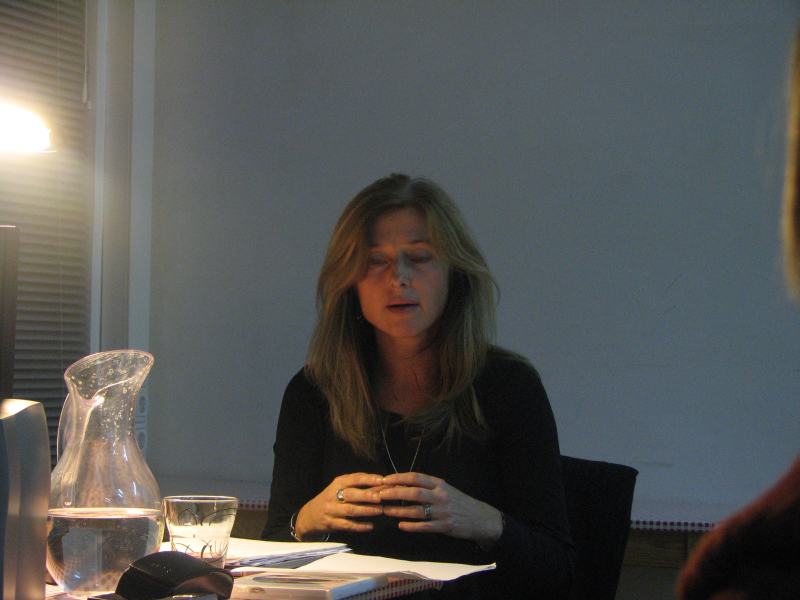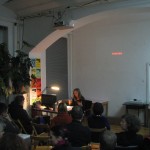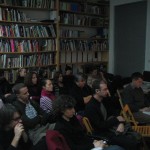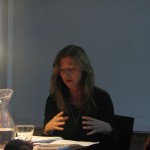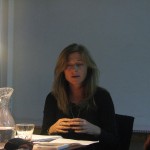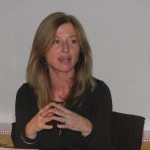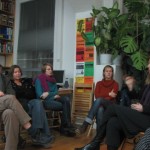Different communities shape their individual and collective identities by using and conventionalising certain forms and principles of communication. A talk, hearing, personal confession, religious confession and interview are different forms of spontaneous or institutionalised communication between an individual and a community, between the private and public spheres. They are mechanisms through which the personal, the intimate (the thought, the experienced, the inner, the potential, the unconscious) is made conscious, rationalised and externalised when articulated in words, statements and signs, becoming the essence and property of the whole community, its collective identity, its public sphere.
With the transformation of social regimes after 1989, East European societies fundamentally changed their habits of communication. Contrary to totalitarian societies recognisable by their powerful ideological and repressive apparatuses, which control or censor individual, critical and spontaneous forms of statement, democratic societies go as far as to idolise all forms of public, spontaneous and critical statements. In the contemporary communication environment of liberal capitalism, interviews, round tables, public discussions, investigations posing questions to those directly involved and the like are canonical forms of communication through which social life as a whole emerges and is regulated. However, we place more trust in a word that comes straight from the heart, which spontaneously emerges before us, than carefully considered, authoritative or authoritarian words in environments governed by the values of liberal capitalism.
By learning and assuming the model of liberal democratic capitalism in the process of so-called transition, East European societies have also taken over a new norm of communication and socialisation. From hiding and supressing one’s personal opinion, individuals are invited to join a society of constant conversation based on ritualised dialogue and idolised extremes, individuality and the bold expression of personal opinion.
Like any institutional form of socialisation, idolised communication and conversation is to some extent ambivalent. The positive and negative effects of the new formula for socialisation work simultaneously. It depends on what stance we take in the existing social current, and on what form of awareness we develop: do we exercise our critical awareness, or are we satisfied by being consumers of institutional ranges of identities? The question is whether we believe every seemingly spontaneous statement, or what kind of critical distance we are able to maintain in relation to surrounding discourses, a distance which we need to set over and over again, as critical awareness needs to be constantly practiced. Its dynamics depend on what criteria and tools we use to fight for our own utterance position in a given social context: are we passive, or do we creatively participate in co-opting our own intervention into the public sphere?
What is an Interview?
The interview is one of the prevailing tools of communication in contemporary Western capitalist culture. “Inter – view”, a compound that originated in English, has become a staple in the international dictionary, as it has been appropriated by most languages. The concept of an “interview” – which emerged with the development of the press and communication technologies (audio and audio-visual footage, radio, television) – first described a genre used in journalism. Dictionaries state that within the scope of this practice, the interview was mostly used for “researching contemporaneity” or “current issues”. Posing questions to individuals regarding a current issue established an overview and view of contemporaneity. Most dictionaries still define the interview as a journalistic form in which “a public person responds to a reporter’s questions”. More comprehensive dictionaries also include other definitions and uses of the word. In addition to the definition of the interview as a journalistic form, the Dictionary of Slovene (SSKJ) defines the interview as 1. “a talk intended for the public in which a person answers prepared questions”, while also offering another definition whereby an interview can be used in other ways, such as in science, statistics, and criminology for collecting data, in which the interview is an element of scientific methodology (2. “collecting information via oral questions and answers”). “Interview” is also the term used to describe the process in which an employer recruits a potential employee and conducts an interview to assess not only whether the person has the necessary professional capacity, but if they are suitable candidates as persons.
Therefore, an interview is primarily concerned with collecting and exchanging information, statements, opinions − an “authentic” testimony which the interviewer provokes with questions. An oral testimony is preferred, which is to be only subsequently, and if necessary, recorded and disseminated in written form (if it is not already originally recorded in increasingly prevalent audio-visual formats). The immediacy of oral testimony is intended to ensure qualities of authenticity and subjectivity, the basic qualities of an interview.
Interview as “Dispositif”
When discussing the practical use of an interview, it needs to be defined what sort of interview is being referred to (journalism, science, research, etc.) or where the interview is to be used (published in a newspaper, aired on the radio, used for company PR, a political party or for an art project).
A more thorough exploration of the question of the origin, nature and function of the interview reveals that it is – on its own – a neutral means, medium or tool with which something can be developed, or some effects can be achieved. Only by using the interview in a given social context, can the (formal and ethical) significance of its effects be assessed.
The interview, which emerged and has been developing along with media technologies and information systems, is performative in its essence. By researching and reporting on contemporaneity and current affairs, it creates a notion about, and establishes authoritative criteria of, contemporaneity.
However, the modern form of the interview, which is based on journalistic practices, is only a sub-genre of a more general and fundamental practice, which is based on a more fundamental condition identifying the human community as a community of communicating creatures who exchange information, opinions etc. The interview is part of the “dispositif” of communication. Foucault’s use of the term “dispositif” assigns to the term the qualities of a complex tool. “Dispositif” is a mechanism, a device. Just as the car (a means or tool of transportation) belongs to the “dispositif” of movement, the interview belongs to the “dispositif” of communication. It is in human nature to communicate, which led to the development of language and other complex systems defining the concept and forms of cultures and civilisations. Complex systems and forms of “knowledge and power” (Foucault) developed via the invention of tools for the most efficient exploitation, use and functionality of these predispositions: we can talk, communicate, move, and so on. Foucault argues that the “function” (how and for what something is used) is the basis of the “dispositifs of power”, while defining the “statement” as the basis for the formation of “discourses”. Conversation, interview, its various functions and characteristic of provoking the other speaker to make statements by posing questions, is at the crossroads of very complex flows of “knowledge and power”.
The interview is potentially a very powerful and even dangerous weapon which can be used for creative, repressive or emancipatory purposes: as a tool for the subordination or emancipation of an individual in the context of a community. The functionalisation and instrumentalisation of conversation is typical of the most authoritative and controversial forms of controlling the relationship between the private and public, the personal and collective in human history. Conversation is a primary form pre-existing various functionalised and specialised forms. The modern – journalistic – implementation described by the term “interview” is only one of the many instrumentalisations of conversation.
Conversation is also a tool used in the Catholic confessional: it is a medium in psychoanalytic practice, and a method of police or political interrogation. In all these examples, conversation is from the outset a neutral, primary form which can be used to provide a constructive and creative boost to the movement between the part and the whole, the individual and the general, the intimate and the public, individual consciousness and the collective norm; or conversation can be abused as a tool for the violent subjugation of the individual to collective norms and consensus.
The operating principles of this sensitive transition point, which is a reference for measuring the ethics and politics of the use of the interview (conversation) can be demonstrated more specifically with a concrete example. If we want to help someone (e.g. a doctor helping a patient, a priest helping a religious person), we must first discover what is bothering them, how they feel their body, and how they experience the world. A patient and a worshipper must first verbalise their condition, communicate it to the person that they are communicating with, from whom they expect help. By making it public, the inner condition is materialised, becomes visible and real. Only in this form can it be subject to exterior intervention or used for a common good. The same rule applies in the opposite direction. If we want to abuse someone, prevent his activity and the like, we must first know how the individual thinks and experiences the world, what the person is planning, and by what beliefs he is driven. We have to prepare the person to tell his thoughts and convictions, to confess that they really exist. In this confession – the articulation of potential that belongs to an individual’s thoughts, feelings and sensations, dreams and wishes – lies a surplus value, an invaluable fuel for the moral drive of human communities, for their potential for revitalisation, or their self-destruction.
inter/View and the Ideologies of Modernity
The twentieth century, the century of modernity, was marked by a radical shift in paradigm, when religious and idealistic social management models which had long been dominant, with surplus moral value, were replaced by materialistic, scientific, secular models.
Two of the most prominent prophets of modernity, Karl Marx and Sigmund Freud, applied the scientific method to the mind and society and subjected them to scientific analysis. Former transcendental concepts, such as the soul, eternity etc. were replaced by immanent concepts like psyche-subjectivity, nature, society, history. Former ethical models, which emerged in connection to the concepts of good and evil, sin and absolution, were replaced by new ethical models emphasising the rational analyses which fashion and socialise us as human beings. By understanding the principles of how nature and society work and by analysing the mechanisms of the human mind, modern individuals and communities were supposed to have fought their way to full emancipation and the perfection of various forms of individuality and sociality.
By analysing various attempts at the social implementation of twentieth century utopias, we realised that conversation, asking questions, the interview, had been instrumentalised and institutionalised in both dominant alternative attempts as the principal tool shaping and streamlining ideological discourses of modernity. Does not a comparison between the image of Freud’s couch, where a patient relaxes while the analyst tries to draw from the patient’s unconscious mind content and forms to cure and liberate them, and the image of political interrogations by secret police − the KGB, Securitate or Udba in Yugoslavia − who with use of torture and abuse tried to make their victims confess that their dreams and convictions were false, provide a very clear and revealing allegory of the different paths taken by the West (democratic capitalism) and East (communism) in the period of modernity?
The various ideological discourses of modernity in the Cold War were based on differing relationships of the dominant social groups to the issue of the significance and application of an individual’s potential, and the significance and value of their thoughts, beliefs, wishes and ambitions. The general attitude to these core human values legitimised different forms of the use of communication tools and determined how freedom of speech and the press, and artistic and scientific liberties were addressed in a society.
It is typical that artistic practices creatively appropriate and modify current issues, discourses and tools of power. Therefore, it is to be expected that the interview has been in continual use in the visual arts for the last forty years.
Andy Warhol is considered one of the pioneers of the contemporary use of the interview in the visual arts. The magazine inter /View, which he established with his collaborators at The Factory in 1969, was published monthly, created out of the interest in the immediate recording and historicising of fashion and the emerging ‘society of the spectacle’. Warhol was obsessed with recording events on audio and video tape. He conducted the interviews himself, thereby establishing a new model that rejected the stereotype of the traditional report that had been established by dominant journalistic practice. Warhol’s interviews were based on the idea of a conversation between equals in a relaxed atmosphere, accompanied by food and drink, but still intended for magnetic tape.
The change in perception of norms and habits of communication recorded by Western artistic practices from the period of the Cold War − including pop art, minimalism, conceptualism, land art, body art, arte povera, and Fluxus − was already appearing in Western academic circles in the nineteen-eighties as epic, as it introduced into art and art history a completely new law, which the traditional history of art, its methods and theories cannot manage. New academic disciplines emerged, developing new scientific methods of examining artistic and cultural phenomena (visual anthropology, visual culture), while artists also increasingly took over theoretical articulation and interpretation, with interviews and conversations becoming an efficient tool for recording the primary artistic discourses which emerged directly from creative practices.
In artistic practices which developed their primary theories (about the dematerialisation of the object, the significance of ideas and concepts in art, the relationship between linguistic and visual signs, and the open structure of artworks that favours process above the end results of artistic creation), the conversation/interview assumed the function of a tool capable of recording the direct, spontaneous cognitive process of artists, their creative subjectivity.
In the environment of conceptual art, the interview was not only used as a tool for obtaining information, but as a medium for materialising the temporality of the stream of thought, as a medium for objectifying creative subjectivity.
Michael Diers[1] argues that Saul Ostrow and Betsy Sussler, the editors of BOMB magazine, which was known for interviews with artists, greatly valued the format of the interview, not only because it enabled artists to express their opinion publicly, to reflect critically on their work and reception, but because they saw in the interview format an opportunity for the cognitive process to be revealed in a raw, unrefined form which stands on its own. While questions can be drafted in advance and an art work can be analysed by different means, what happens in a conversation is spontaneous and performative, and cannot be comprehensively recorded and preserved. The questions are based on answers; ideas float and consider the atmosphere of the event. While it seems that we can follow a conversational thread as a kind of curve or line, the transcript of a conversation always includes a rhythm, a subtext, and an inner logic which remains implicit. The interview has become another method of documenting prevailing processual and performative artistic practices.
A similar stance on the use of the interview was taken Gwen Allen[2] in her analysis of the work of Avalanche magazine, which featured a presentation of all the heroes of the North American and Western European proto-conceptualist art scene between 1970 and 1976 (Joseph Beuys, Vito Acconci, Robert Smithson, Lawrence Wiener, Yvonne Rainer and many others).
The editorial policy of Willoughby Sharp and Liza Bear was to support the direct artistic voice. Instead of following established practice, like the majority of arts magazines which published opinion pieces by critics and art historians, Avalanche presented documentation about current artistic processes and interviews with artists. The covers of individual issues included monochrome portraits of the artists, while intensive dialogues with artists and a presentation of their creative methods and processes filled the pages inside. The editorial strategy, which sought to increase the individuality of the artist vis-à-vis the increasingly dominant and depersonalised art system, saw Avalanche mimic the current strategies of the dominant cultures that nurtured the cult of the star. While the interviews and portraits borrowed the main features of popular magazines such as Playboy, Rolling Stone or Interview, their content promoted a quality of glamour which was completely opposite. The ruffled, unshaven and defiant faces of then unknown artists and the planned informality of interviews expressed the spirit of the vital alternative cultural policy of the 1970s in the USA. Allen maintains that it functioned as a gallery without walls, which represented art that sought to avoid architectural and institutional confines.
Sharp and Bear were sensitive to changes in the perceptual norms and communication habits of the emerging post-industrial society, which was marked by the unstoppable expansion of commercial culture and the culture industries. According to the editors, for American artists at the turn of the 1960s, being present in the media was no longer a matter of choice; it was a necessity. Therefore, they conceived a medium which aimed to support the direct voices of artists by means of the culture industries.
The views of the editors matched the concepts, critical analyses and theories developed by the artists who collaborated with them. The creative dialogue between Sharp and Robert Smithson led to the choice of a geological metaphor for the name of the magazine (Avalanche) and the understanding of the magazine’s social function through Smithson’s concept of non-sites such as galleries, media, museums and collections, where an artist was to present only the documentation of their remote and hard to access (land art) work. In his interview with Sharp[3], Smithson defines non-sites as the central focal points in contemporary society, while the site operated more from the fringes. “One might even say,” says Smithson, “that the place has absconded or been lost.” In a sense, the “non-site” is the centre of the system, while the ‘site’ constitutes its fringe.
Therefore, Avalanche was a project that established a generation of artists with a careful media strategy which rushed like an avalanche from the fringes to the centre. In six years, Avalanche published sixty-one interviews and conversations with artists now viewed as paradigmatic (Andre, Dibbests, Smithson, Oppenheim, Nauman, Weiner, Matta-Clark, Glass, Kounellis, Rainer, General idea, Acconci, Ruscha, Burden, Buren, Monk and others) which were conducted by the editors themselves. Like Warhol, Sharp and Bear insisted that the interviewer and interviewee share a similar artistic sensitivity. Gwen Allen argues that this approach resulted in interviews which are extremely idiosyncratic, and convincingly transfer the emotional details and informal qualities of inter-subject exchanges to paper. They succeeded in capturing the rhythms and cadences of natural speech, complete with pauses, silences, absurdities and linguistic automatisms. The interviewer and interviewee are simply thinking aloud, interrupting each other’s sentences, completing each other’s thoughts. Like Warhol’s interviews, Avalanche’s conversations took place after a meal, sometimes in the afternoon, or long into the night, accompanied by coffee, cigarettes, joints and alcohol.
The paradox of Warhol’s project and similar ones − which gave the interview a new meaning in the context of the more recent history of art − is that they were conceived in order to empower the artists, to place in the limelight a way of life and thinking typical of social fringes, within the scope of an effort to trans-substantiate site into non-site, but were forced to shape their image and format with precise means, like popular and commercial culture, which were flooded by the cult of the star in this period.
Analysts of proto-conceptual artistic practices agree that interviews operate in a kind of “active split”. Regardless of the utopia that their work seeks to contribute to the de-alienation and emancipation built by artist on the basis of reading contemporary radical theories (Marcuse, Adorno, Horkheimer, Gestalt psychology, Lacan etc.), these practices − consciously or as a side-effect − sensitively recorded the structural rules of the flourishing of the administrative/bureaucratic culture, the culture of archiving and a media culture in post-industrial society.
In his analysis of the work of Dan Graham, Performer/Audience Sequence and Present Continuous Past(s), Thierry de Duve[4] argues that Graham, despite seeking to be critical of society, with some projects created an efficient impersonal allegory of a society without transcendence and finiteness, a society of the continuous mediatisation of society, caught in the endless openness of its homeostatic machinery. According to de Duve, already the next generation, the generation of the 1980s, read the Frankfurt philosophers and conceptual art in a particular non-utopian fashion, or even cynically, via the punk slogan “No Future”, via strategies of appropriation, quotation and copying, which commented on the laws of the fetishisation of art objects and the mechanisms of media constructs of historical subjectivity.
Interview and Performativity
In the 1990s, after the fall of the Berlin Wall, with the expansion of globalisation and new information technologies, the world was caught in the stranglehold of a new paradigmatic shift, which, according to experts, is characterised by a decline in representational culture and the advancement of the performative. In the deluge of the new, which promptly becomes outdated, it seems that the world can be understood and be active in it only through continuous communication, conversation, exchange of opinion, of constantly being pluged into an inter-subjective network. Reflection and activity have become simultaneous processes, caught in the endless circle of a single, homeostatic loop. Critical previsions of the non-site, which subverts the site (Smithson), or the allegory of constructing historical subjectivity in media culture, where a place or event recorded by the media becomes old every eight seconds, until it is completely pushed out of the visual field (Graham, Present Continuous Past(s)) in one minute, the logic of copying and quoting, expanded in the 1990s in the everyday living environment, where, according to new-era analysts, the simulacrum is becoming more real than its model or completely indistinguishable.
The overflow of rapid interviews, debates and chats which have flooded the Internet have also promoted a radical critical analysis of the interview as a tool of media manipulation. Artists quickly became accustomed to the power ascribed to their direct statement in the context of the art system, which finally appropriated the star cult in the 1980s. They began adapting their statements to the effect that they had in the media. The 1970s had already seen the emergence of doubts with regard to the reliability of interviews with artists, as it is in the nature of artists, according to Lawrence Alloway, to try to deceive or manipulate critics to the benefit of the artists’ personal mythologies. Direct contact with an artist enables a critic or historian to obtain precise information which could not have been acquired from other sources, while the critic may be manipulated. The increasing use of interviews as a method of uncritical lauding of the artist’s ego prompted the Russian curator and critic Olia Lianina to reject the interview entirely, because she believes that, since Warhol, minimalists and conceptualists, it has produced stars instead of ideas.
Despite well-founded criticism, the conversation and interview proved to be efficient tools even in the 1990s, where, in accordance with their paradoxical, dual nature, they concurrently established, commented on and reflected the particularly performative nature of the new era.
In the 1990s, together with the Irwin artists collective, I was able to test the efficiency of conversations and interviews as tools in a series of projects (NSK Moscow Embassy, Interpol, Transnacionala), which sought to reflect and record mental, emotional and social processes since the fall of the Berlin Wall, the direct exchange of general value systems typical of social transition. In view of the objective, the direct recording of conversation proved to be an efficient tool for preserving inter-subjective processes, where our subjectivities in real time performatively bade farewell to the content, experience, and value parameters of real-socialism and adapted to the imperative and rituals of the new social reality of liberal capitalism. Invisible inter-subjective psychological processes, which were at the forefront of the mentioned projects, were also complementary to more visible economic and social processes, which were clearly recorded in urban structures, among others. During the operation of the NSK Embassy in Moscow, Russia was being penetrated by the Western market, which translated in urban spaces into a palimpsest language of two economies. A large department store near Lenin Prospect 12, where the NSK Embassy operated, was leased unit by unit to sellers of Western merchandise, while the remainder continued to be used to sell mostly cheaper Russian products. The streets were also a rich symbolic mixture of old and new facades. The moment in the future − which now lies in the past – when the old world disappeared behind the new facades was easy to predict.
Within the scope of the global art system, a new meaning and role was achieved by the curator Hans Ulrich Obrist through a series of extensive and influential interviews with artists and scientists.
For Obrist, the interview was a tool of “endless conversation”, which also recorded the direct “art history of the presence”.[5] According to Michael Diers, Obrist’s interviews are encyclopaedic − archives and collections of thoughts of some kind, the views and opinions of creative individuals. Contrary to the demand for the complete, contemplative atmosphere of Warhol’s or Avalanche’s interviews, Obrist’s interviews took place in any possible and impossible situations − on planes, in taxis, in lifts, over the telephone, by fax or e-mail. Generally, the interviews were not pre-planned, but usually side products of other events (exhibitions, symposia, conferences). The main thread of Obrist’s extensive interview project, which imbues it with an authorial coherence, is his indestructible passion for conversation, which motivates him to discuss complex abstract issues with his interviewees regardless of the obstacles imposed by the context.
As established in one of Obrist’s interviews with the artist Douglas Gordon[6], the differences between the present and past generations of artists are not defined so much by an increased flow of image and information, but by simultaneity and the dispersal of activities and impulses which constantly interrupt the direct contemplative or communication flow. Just as historical memory is paradoxically weaker in a world which extensively records and archives every minute activity, direct complete inter-subjective communication is driven from the world of extensive communication realised through conversation or interview. From the moment that Gordon and Obrist entered the flat where they were to conduct an interview in real time, this current, says Gordon, was bound up with countless parallel processes – from telephones ringing, to street noise, to jumping between topics, and urgent little activities. According to Gordon neither the contemplative Broodthaers nor someone like Duchamp could live in the way which all of us living and working in the current times do, where we, exposed to continuous sensations of multiple currents, lose the quality characteristic of full and focused cognitive and communication processes.
Conclusion – Interview as a Tool of Conceptualisation
Within the scope of the workshop we narrowed the field of the interview to the field of contemporary art. We tried to think about the interview as a tool of conceptualisation (creative contemplation, preparation, creative processes) used by different practices connected to the field of contemporary art. The interview (which can be recorded on audio or video tape) can be used in the research (creative) stage of an independent art project, exhibition, dissertation, review or other similar activity.
Regardless of the awareness of the paradoxical and ambivalent nature of the interview, which should encourage us to use it with caution, its inexhaustible source of vitality is the fact that the interview is so well suited for researching and discovering the unknown – its tendency to encourage saying out loud what had previously been unsaid. According to Hans-Georg Gadamer[7] the oral and immediate quality of conversation is what gives the interview its vitality and controversy, as oral articulation successfully brings together and mixes rational and emotional elements of utterance. The interview becomes a true creative adventure in the moments when the interviewer manages to encourage or provoke the interviewee to utter content which is not repeated based on previously articulated models but expresses immediate rational and emotional currents, which surprise and inspire both the person uttering them and the one asking questions, connecting them in a shared communicative adventure. Despite seeking to constantly explain them, the human psyche, our cognitive and emotional processes remain mysterious and unpredictable. They include a goldmine of potential, half-conscious or unconscious content that exists in potential form and which will not be expressed unless provoked. The interviewer is the person managing this sensitive tool aimed to challenge. The path to exciting and passionate conversation is reached via exciting and passionate questions.
First published: Eda Čufer, “The Interview as a Tool”, Artwords, No. 77, 78 (Winter 2006), pp. 154–161.
[1] Michael Diers, “Infinite Conversation or the Interview as an Art Form”, in: Hans Ulrich Obrist, Interviews, Volume1, Charta, 2003.
[2] Gwen Allen, “In on the Ground Floor: Avalanche and the Soho Art Scene 1970−1976”, Artforum, November 2005.
[3] “Discussion with Heizer, Oppenheim, Smithson”, Avalanche, 1970.
[4] Dan Graham, Works 1965–2000, Richter Verlag, Dusseldorf , 2001. Thierry de Duve, Dan Graham and the Critique of Artistic Autonomy, Richter Verlag, Dusseldorf , 2001.
[5] The concept of “endless conversation” was taken by Obrist from the title of a book by Maurice Blanchot published in 1969, while the concept of the “art history of the presence” was borrowed from historian Timothy Garton Ash, who used the term to refer to political changes in Eastern Europe which he recorded promptly, as he was convinced that the changes were happening so quickly that history might miss the essential details if he did not record them.
[6] Hans Ulrich Obrist, Interviews, Volume1, Charta, Milan, 2003, p. 317.
[7] Hans Ulrich Obrist, Interviews, Volume1, Charta, Milan, 2003, p. 244.
